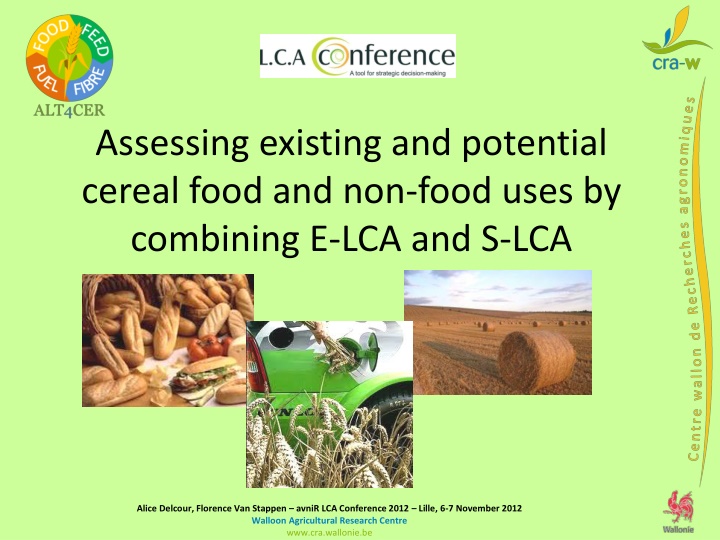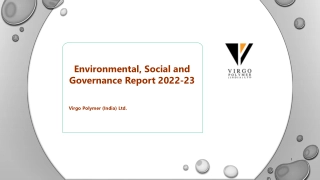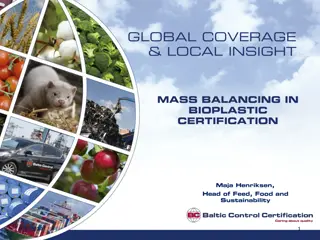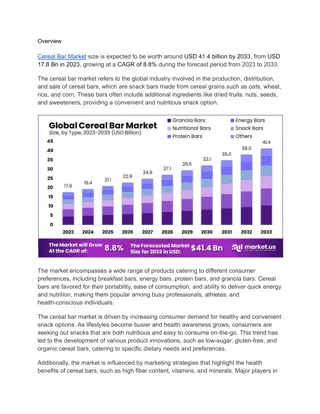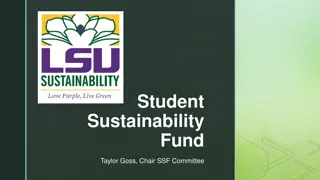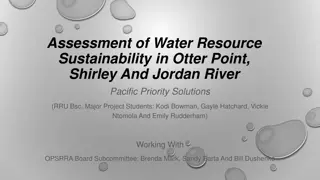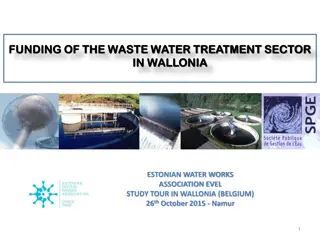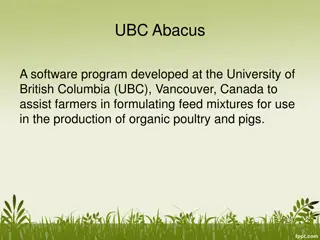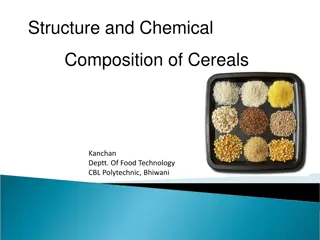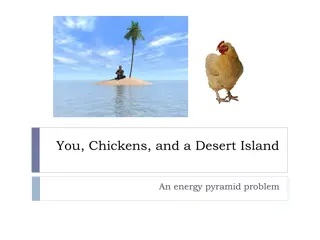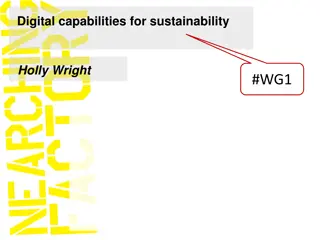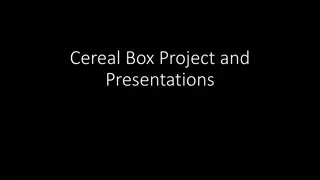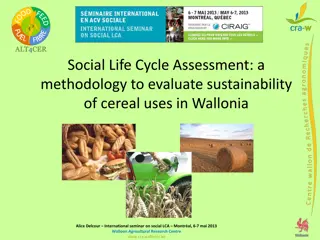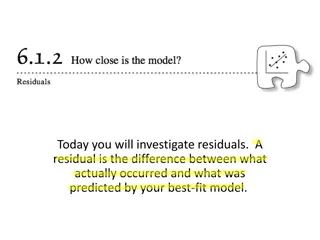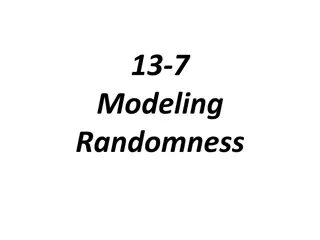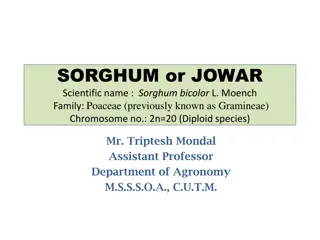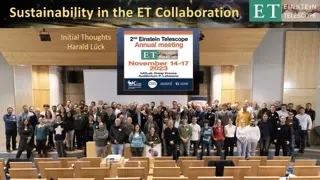Assessing Cereal Uses for Sustainability in Wallonia
This study explores the current and potential food and non-food uses of cereals in Wallonia by combining environmental and socio-economic life cycle assessments. It investigates scenarios for 2030, including business-as-usual trends, strategic optimization, local development, and global market focus. Stakeholders, including farmers and researchers, play a crucial role in defining sustainable and efficient uses of cereal resources in the region.
Download Presentation

Please find below an Image/Link to download the presentation.
The content on the website is provided AS IS for your information and personal use only. It may not be sold, licensed, or shared on other websites without obtaining consent from the author.If you encounter any issues during the download, it is possible that the publisher has removed the file from their server.
You are allowed to download the files provided on this website for personal or commercial use, subject to the condition that they are used lawfully. All files are the property of their respective owners.
The content on the website is provided AS IS for your information and personal use only. It may not be sold, licensed, or shared on other websites without obtaining consent from the author.
E N D
Presentation Transcript
Assessing existing and potential cereal food and non-food uses by combining E-LCA and S-LCA Alice Delcour, Florence Van Stappen avniR LCA Conference2012 Lille, 6-7 November 2012 Walloon Agricultural Research Centre www.cra.wallonie.be
Cereals food and non-food uses: 4F Cereals Human food uses Animal feed uses Material uses Energy uses FUEL FIBRE FOOD FEED Alice Delcour, Florence Van Stappen avniR LCA Conference 2012 Lille, 6-7 November 2012 Walloon Agricultural Research Centre www.cra.wallonie.be
ALT-4-CER: which Fs of the 4F for Wallonia? Key steps: STAKEHOLDERS 1. To draw the portrait of the Walloon cereals, and their current and future/potential uses To define several scenarios 2030 acc. to current trends (B-a-U) and contrasting breaks To develop environmental and socio- economic LCA methodologies fed with local data To integrate environmental and socio- economic aspects through multi- criteria analysis with stakeholders To provide clues for most sustainable and pertinent uses of the cereal resources in Wallonia questions / answers 2. SCENARIOS 4F 3. adaptation answers E-LCA S-LCA 4. demand offer LOCAL DATA Alice Delcour, Florence Van Stappen avniR LCA Conference 2012 Lille, 6-7 November 2012 Walloon Agricultural Research Centre www.cra.wallonie.be
Walloon context: main crops (% cultivated lands) Winter wheat Winter barley 7% 3% 8% Spelt Cereals: 66% 2% Grain maize 2% Forage maize 36% Sugar beet 12% Chicory Linseed Rapeseed 10% 16% Potato 3% Temporary meadows 1% 1% Flanders Flanders Source: DGSIE (INS)- Recensement agricole 2010 Wallonia Wallonia Brussels- Capital Capital Brussels- Alice Delcour, Florence Van Stappen avniR LCA Conference 2012 Lille, 6-7 November 2012 Walloon Agricultural Research Centre www.cra.wallonie.be
6% 31% 16% Scenarios 2030: Grains + straw + forage maize 13% 17% 16% 12% Business-as-Usual: current trends extrapolated from past 15 years Strategic: environmental, economic and social optimization of current system Localisation: development of new cereal conversion units in Wallonia + increased autonomy Globalisation: massive export + focus on high added-value products (biorefinery, bio-based chemistry) 5% 6% 8% 9% 4% 1. 2. 3. 15% 16% 25% 33% 28% 64% 11% 57% 43% 28% 36% 4. 4 500 4 000 6% 3 500 16% 31% 3 000 13% 5% Export 6% 1000 T DM 8% 2 500 17% 16% 9% Fibre (litter, insulator) 12% Fuel/Biorefinery 1G+2G 2 000 16% 28% 11% 33% Feed 1 500 Food 64% 43% 1 000 57% 36% 500 28% 25% 15% 4% 0 Alice Delcour, Florence Van Stappen avniR LCA Conference 2012 Lille, 6-7 November 2012 Walloon Agricultural Research Centre www.cra.wallonie.be 2010 - baseline 2030 - B-a-U 2030 - strategic 2030 - localisation 2030 - globalisation
Scenarios analysis with E-LCA & S-LCA Cover the 3 pillars of sustainable development Common objective: evaluate environmental and socio-economic consequences of potential changes in the uses of Walloon cereals by 2030, in comparison with current situation (2010) Consequential LCA Society Ecology Economy E-LCA & S-LCA specific objectives: assess influence of cereal use chains on environmental & socio-economic performances within a given scenario Attributional LCA Common 4F functional unit = 1 ha Alice Delcour, Florence Van Stappen avniR LCA Conference 2012 Lille, 6-7 November 2012 Walloon Agricultural Research Centre www.cra.wallonie.be
System boundaries in E-LCA & S-LCA Local communities Workers Companies Farmers S-LCA Agricultural inputs manufacturers Grain wholesalers Cereal producers Processing Distributers Consumers Agricultural machinery manufacturers Agricultural contractors Animal breeder/ rearer Processing E-LCA Alice Delcour, Florence Van Stappen avniR LCA Conference 2012 Lille, 6-7 November 2012 Walloon Agricultural Research Centre www.cra.wallonie.be Physical flow between actors (transport) Influence between actors
Scenarios analysis with E-LCA Environmental LCA identify regional differencies regarding the cultivation step: (New) cropping practices; Machinery characteristics & fuel consumption; Direct field emissions assessment; Inputs management; Animal feeding & husbandry; etc + Conversion processes based on existing facilities Alice Delcour, Florence Van Stappen avniR LCA Conference 2012 Lille, 6-7 November 2012 Walloon Agricultural Research Centre www.cra.wallonie.be
Scenarios analysis with S-LCA Stakeholders categories Workers Companies Farmers (Local communities) Impact categories Impact subcategories Workings hours Health and safety at work Local employment Added value creation Working conditions Socio-economic repercussions Alice Delcour, Florence Van Stappen avniR LCA Conference 2012 Lille, 6-7 November 2012 Walloon Agricultural Research Centre www.cra.wallonie.be 9
Data inventory in S-LCA & LCC Working conditions: interviews: Using methodology Bilan Travail (labor balance for production step): Developed by INRA & Institut de l Elevage in order to assess work types and share for animal rearing systems To be adapted for cropping systems Use farms accounting data collected at the Walloon Region level (FADN-like) (production step) Transformation step: data collection from existing facilities Alice Delcour, Florence Van Stappen avniR LCA Conference 2012 Lille, 6-7 November 2012 Walloon Agricultural Research Centre www.cra.wallonie.be 10
Life Cycle Costing Detailed costs balance of cereal chains is not the objective of our project not a traditional LLC but a valuation of distribution of added value Objective: compare best value chain by studying distribution of costs according to chain link rather than an accurate estimation of their evolution in absolute value Are included: stocks, sales, raw materials, labour force costs, etc. Could be distributed according to working hours for example Centre wallon de Recherches agronomiques Unit Biomasse, bioproduits et nergie www.cra.wallonie.be 11
Multi-criteria Analysis Integrate environmental and socio-economic impacts (E-LCA & S-LCA results) Involve stakeholders (producers, policy makers, consumers): Identify most relevant impact categories, group/prioritize (Weight into a global performance indicator?) Alice Delcour, Florence Van Stappen avniR LCA Conference 2012 Lille, 6-7 November 2012 Walloon Agricultural Research Centre www.cra.wallonie.be 12
Midpoint Endpoint Human & eco-toxicity Ozone layer depletion Human health Climate change Ecosystem quality Acidification LCI data Eutrophication Resources Integration Abiotic resources use Working hours Working conditions Health & Safety at work Local employment Socio-economic repercussions E-LCA Added value creation S-LCA Subcategories Impact categories Alice Delcour, Florence Van Stappen avniR LCA Conference 2012 Lille, 6-7 November 2012 Walloon Agricultural Research Centre www.cra.wallonie.be 13
ALT-4-CER: Expected results Key features of the project: To involve local stakeholders in all steps (scenario building, data collection, impact weighting) To use local data for local issues Answer key questions raised today in human Societies: What type of agriculture do we want for tomorrow? Is it ethically, environmentally and economically sustainable to dedicate cereals resources to other uses than human food? End of project: February 2014 Alice Delcour, Florence Van Stappen avniR LCA Conference 2012 Lille, 6-7 November 2012 Walloon Agricultural Research Centre www.cra.wallonie.be
Thank you for your attention! Contact: Alice DELCOUR, Florence VAN STAPPEN Walloon Agricultural Research Centre a. delcour@cra.wallonie.be, vanstappen@cra.wallonie.be Alice Delcour, Florence Van Stappen avniR LCA Conference 2012 Lille, 6-7 November 2012 Walloon Agricultural Research Centre www.cra.wallonie.be
